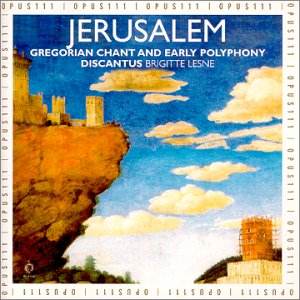Jerusalem - Gregorian Chant and Early Polyphony
 Discantis Conducted by - Brigitte
Lesne
Discantis Conducted by - Brigitte
Lesne
 Recorded September 1999 in
Abbay de Caunes Minervois, France.OPUS 111 OPS 30-291 DDD [67.24]
Recorded September 1999 in
Abbay de Caunes Minervois, France.OPUS 111 OPS 30-291 DDD [67.24]
Crotchet
Amazon
UK
Amazon
USA

This is a disc which has resulted from detailed academic research carried
out in France by among others, Brigitte Lesne, the singing director of the
all-female voiced choir called Discanus. This group was founded by Mlle Lesne
in 1998 after she had been involved in the establishment of the Centre for
Medieval Studies in Paris. This has evidently given her a very good grounding
in early vocal music from medieval chant to early polyphonic music. The group
has released other discs of early music, and this release has been produced
in conjunction with Sylvanes Abbey.
The Abbey, established in the 12th Century, is based in Southern Aveyron
in the mid-Pyrenees. In 1975, Father Andre Gouzes undertook to restore the
building, after it had been abandoned for two centuries. The Society formed
to help with this restoration organises a variety of sponsorships and other
activities. This disc is one of its activities.
We have here various musical items, with the sound picture being varied by
moving between early polyphony and Gregorian chant. The prevents the disc
from becoming too similar, track to track. All the singers, identified separately
against every track in the very informative booklet, have clear, strong and
very attractive voices throughout.
The only problem with a disc of this kind is that an element of boredom sets
in if one listens to the entire disc without a break. However, if you are
interested in this type of music, this is not a factor, and it can be recommended
without reservation.
The disc was inspired by the Holy City, both from a mythical and realistic
standpoint. The works celebrate this unique, universally recognised destiny
on the threshold of the third millennium.
The sources of material are various, and come from a wide range of time periods.
Some of the earlier pieces were originally transmitted orally, coming as
they do from the 5th Century. Some of the texts are taken from the Scriptures,
others from much later written texts. The unifying theme is that of Jerusalem,
and the texts reinforce the feeling of unity, albeit with such varied sources
of material.
The recordings, made in Abbaye de Caunes Minervois, are both warm and spacious,
and if there was any slight qualm about the sound, it would be that it is
perhaps a little too close. We therefore lose some of the ambience of the
Abbey. The texts are nevertheless always clearly heard.
Reviewer
John Phillips

